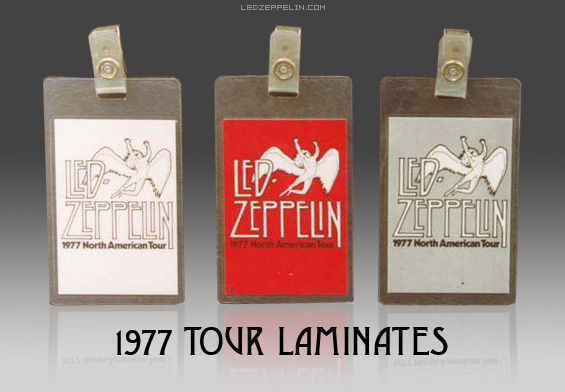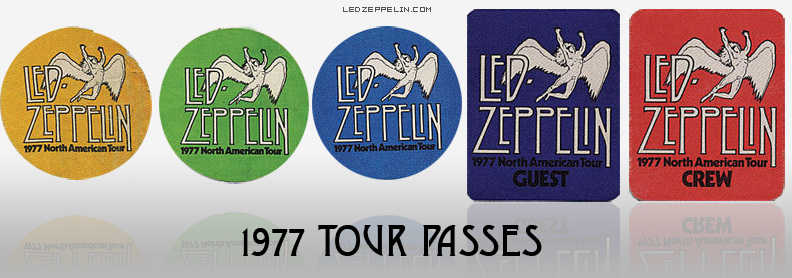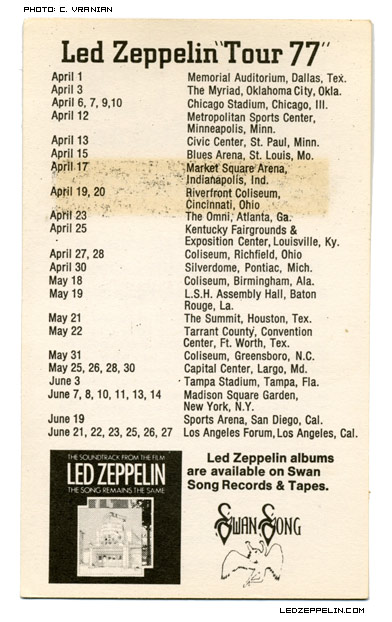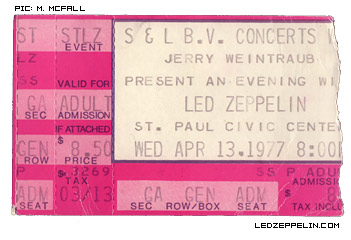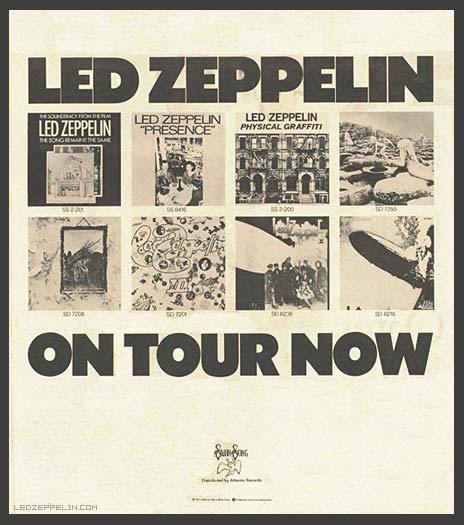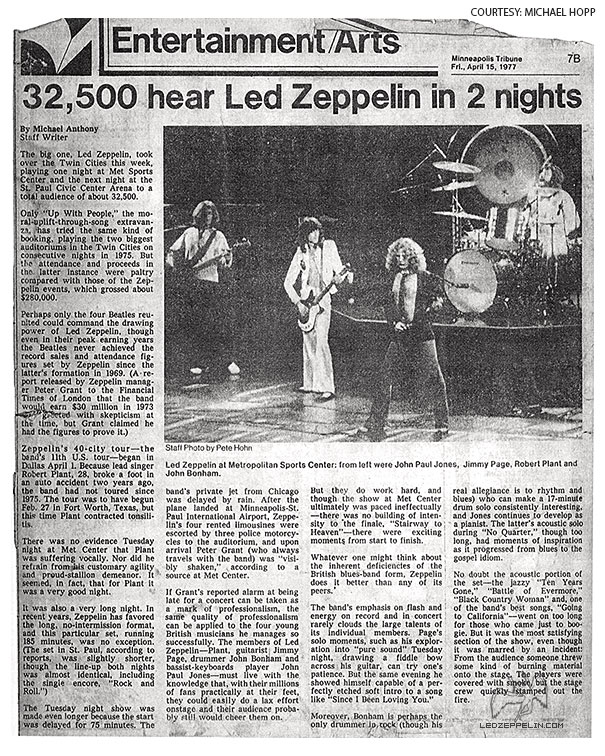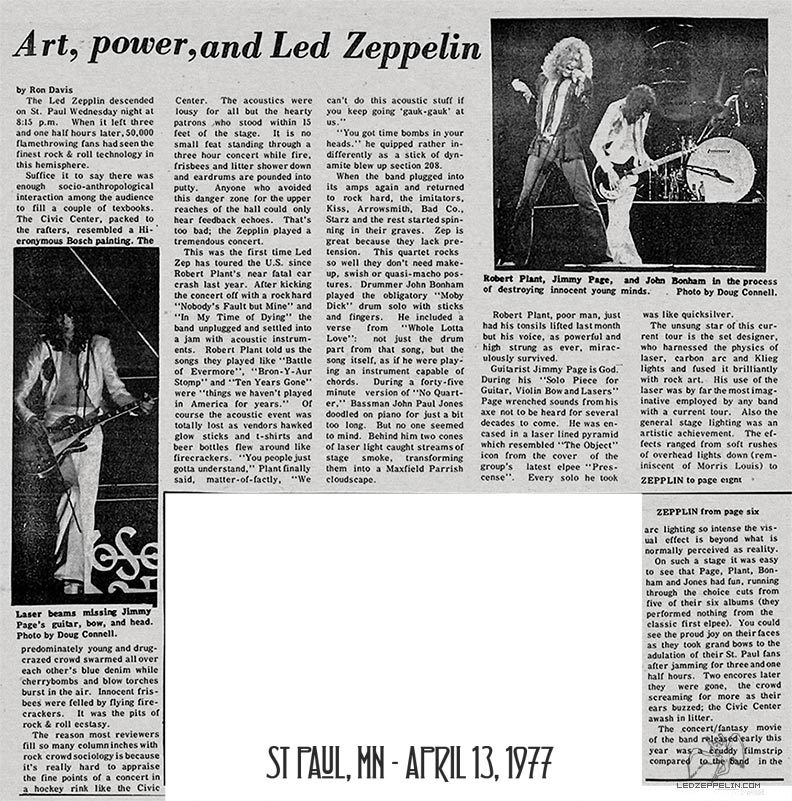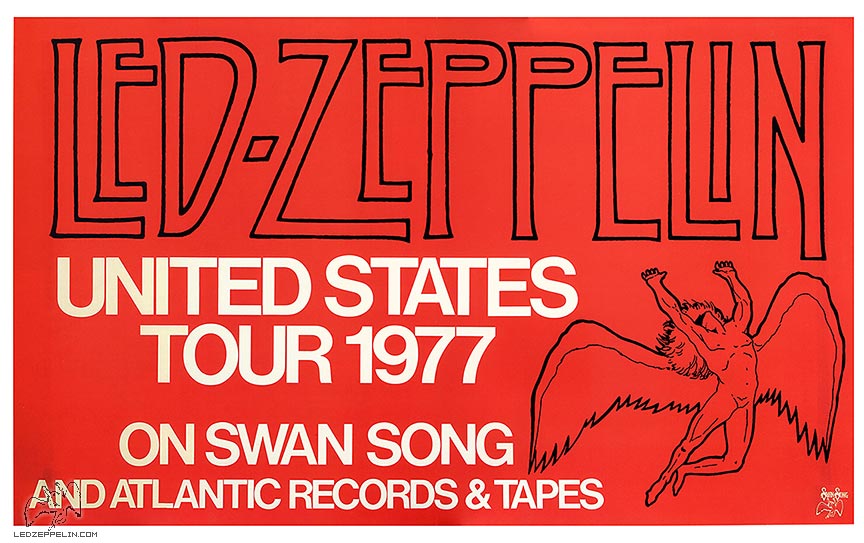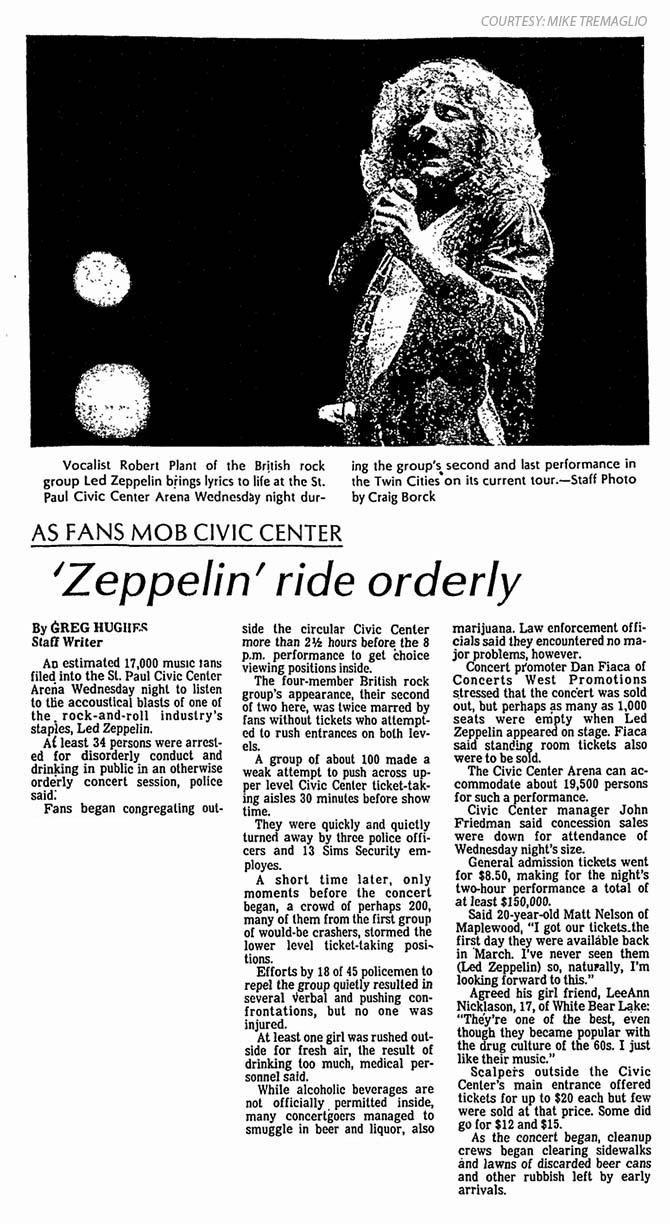Includes: The Song Remains The Same, (The Rover intro) Sick Again, Nobody's Fault But Mine, In My Time of Dying, Since I've Been Loving You, No Quarter, Ten Years Gone, Battle of Evermore, Going to California, Black Country Woman, Bron-Y-Aur Stomp, Trampled Under Foot, White Summer ~ Black Mountain Side, Kashmir, (Out On the Tiles intro) Moby Dick, Jimmy Page solo, Achilles Last Stand, Stairway to Heaven, Rock and Roll, Black Dog.
 |
Click here to view the US '77 Tour Programme (flipbook) |
Press Review: The Song Remains In Flux - Minnesota 1977
First of all, they should drop that opening theme song. It’s a misnomer. Any Zeppy who’s held control of their ears and brain over the past seven years knows that the song hasn’t been the same since Zeppelin II. Live, the British bombardiers, themselves, revealed the title to be a lie during their two vastly different performances last week in the Twin Cities. If anything, they proved that the song remains in flux, from phase to phase, album to album or even night to night.
In the long run, this constant change has preserved vitality in their music which the blues R&R stagnation wished on them by their reactionary legions would have sapped. In the short run, from night to night, however, it meant the difference between the adrenaline explosion of their Civic Centre performance and the monotonous thud of the previous night’s show at the Met Sports Center.
Both of these sold-out concerts (that’s about 33,000 bodies paying a gross of $278,000) followed essentially the same program, opening with the aforementioned Song Remains the Same, and closing over three hours later with the encore, Rock & Roll. In between there were, of course, three 20-minute solos – guitar, drums and piano – and the musical emphasis for this tour seems to be on their 1975 album Physical Graffiti.
The main difference between the two shows was the group’s energy levels (not to be confused with the volume level), which always remained at the same D-day.
Indicative of the Met show was Jimmy Page sloppily playing a grind-‘em-til-you-find-‘em guitar solo while slouching on a kitchen stool borrowed from Andy Williams. The next night he played the same solo, tightened up tremendously, accenting it with a twisting shuffle, smiles and a rock and roll leap. He had instant audience rapport, playing with and off the crowd rather than in spite of it.
The Met’s slack-happy performance can be partially attributed to their weather-delayed departure from Chicago (their permanent shuttle home-base for this part of the tour.) They were detained at O’Hare Airport until 7:40; arrived in Bloomington at 8:35; made the Met at 8:50 and hit the stage at 9:10. By encore time, 12:15, their stamina reserves were obviously wasted, as evidenced by their shaky stage sauntering and pallid expressions.
The tour photographer, Neal Preston, gave a succinct after-show critique, remarking: “Well, it was probably the worst Led Zeppelin concert I’d ever seen”. (He’s travelled with the group since 1973).
But even this “worst performance ever” held some musical surprises for the less frequent spectator. Keyboardist John Paul Jones’ extended, meaty-chord solo provided a moody bridge between No Quarter and Ten Years Gone. Page, taking most of the leads, led the group through an acoustic half hour. Their offering of English folk-style songs – Black Country Woman, Bron-y-aur Stomp, and Going to California – transformed these champions of heavy metal into a sort of Chieftains gone Haight-Ashbury. They played their wooden instruments proudly and expertly.
However, any momentum that could have been built during this section of obvious band conviction was quickly defeated when some peabrain threw a South Dakota stink-bomb special onto the stage.
The whole group, especially Robert Plant, seemed pissed off about the onslaught of fireworks that’s been greeting them on this tour. On both nights he requested that the crowd keep the fireworks until the fourth. The week before in Chicago, he had reportedly threatened to leave the stage. At St Paul, he reached back to the past for a hippie attempt at communication. “How are we supposed to sing about flowers and love when you’re all packing bombs? It’s silly, isn’t it?”
Led Zeppelin’s music is itself built on distortion and flash, but they stand head and shoulders over their minor-league, bomb popping competition because they continue to connect it all into a purposeful extremely forceful musical whole. Basically, they are better musicians than they are schlock mongers. Although they do dabble self-indulgently in lasers, dry-ice clouds and white noise generators, they have enough integrity to keep them in their proper perspective. On both nights, most effects were followed instantaneously by an ensemble surge or more often by a tight-paced, dexterous guitar break from Page.
John Bonham, the most steady component both nights, drummed a heavy bottom, a tom-tom, and bass driven funk dance. The usually stoic John Paul Jones filled out the bottom doing a booty shaker bump off Page all the while.
Their St Paul finale of Stairway to Heaven was something that I wished those who’d sat through the show the night before or even in 1973 or January 1975 could have witnessed. They finally did this war horse right, with none of the rough draft doodling or uninspired mess that I’d come to expect from the song. They did it vinyl perfect, true to the record but with musical fire and spunk. Page augmented his usual break with a fierce fingered solo that it probably took countless performances to reach and as is the group’s nature, will probably take as many more to hit again. Such is the life of a band in flux. [T.Carr-Live Licks | April 1977]
 |
Click here to view the US '77 Tour Programme (flipbook) |
Press Review: The Song Remains In Flux - Minnesota 1977
First of all, they should drop that opening theme song. It’s a misnomer. Any Zeppy who’s held control of their ears and brain over the past seven years knows that the song hasn’t been the same since Zeppelin II. Live, the British bombardiers, themselves, revealed the title to be a lie during their two vastly different performances last week in the Twin Cities. If anything, they proved that the song remains in flux, from phase to phase, album to album or even night to night.
In the long run, this constant change has preserved vitality in their music which the blues R&R stagnation wished on them by their reactionary legions would have sapped. In the short run, from night to night, however, it meant the difference between the adrenaline explosion of their Civic Centre performance and the monotonous thud of the previous night’s show at the Met Sports Center.
Both of these sold-out concerts (that’s about 33,000 bodies paying a gross of $278,000) followed essentially the same program, opening with the aforementioned Song Remains the Same, and closing over three hours later with the encore, Rock & Roll. In between there were, of course, three 20-minute solos – guitar, drums and piano – and the musical emphasis for this tour seems to be on their 1975 album Physical Graffiti.
The main difference between the two shows was the group’s energy levels (not to be confused with the volume level), which always remained at the same D-day.
Indicative of the Met show was Jimmy Page sloppily playing a grind-‘em-til-you-find-‘em guitar solo while slouching on a kitchen stool borrowed from Andy Williams. The next night he played the same solo, tightened up tremendously, accenting it with a twisting shuffle, smiles and a rock and roll leap. He had instant audience rapport, playing with and off the crowd rather than in spite of it.
The Met’s slack-happy performance can be partially attributed to their weather-delayed departure from Chicago (their permanent shuttle home-base for this part of the tour.) They were detained at O’Hare Airport until 7:40; arrived in Bloomington at 8:35; made the Met at 8:50 and hit the stage at 9:10. By encore time, 12:15, their stamina reserves were obviously wasted, as evidenced by their shaky stage sauntering and pallid expressions.
The tour photographer, Neal Preston, gave a succinct after-show critique, remarking: “Well, it was probably the worst Led Zeppelin concert I’d ever seen”. (He’s travelled with the group since 1973).
But even this “worst performance ever” held some musical surprises for the less frequent spectator. Keyboardist John Paul Jones’ extended, meaty-chord solo provided a moody bridge between No Quarter and Ten Years Gone. Page, taking most of the leads, led the group through an acoustic half hour. Their offering of English folk-style songs – Black Country Woman, Bron-y-aur Stomp, and Going to California – transformed these champions of heavy metal into a sort of Chieftains gone Haight-Ashbury. They played their wooden instruments proudly and expertly.
However, any momentum that could have been built during this section of obvious band conviction was quickly defeated when some peabrain threw a South Dakota stink-bomb special onto the stage.
The whole group, especially Robert Plant, seemed pissed off about the onslaught of fireworks that’s been greeting them on this tour. On both nights he requested that the crowd keep the fireworks until the fourth. The week before in Chicago, he had reportedly threatened to leave the stage. At St Paul, he reached back to the past for a hippie attempt at communication. “How are we supposed to sing about flowers and love when you’re all packing bombs? It’s silly, isn’t it?”
Led Zeppelin’s music is itself built on distortion and flash, but they stand head and shoulders over their minor-league, bomb popping competition because they continue to connect it all into a purposeful extremely forceful musical whole. Basically, they are better musicians than they are schlock mongers. Although they do dabble self-indulgently in lasers, dry-ice clouds and white noise generators, they have enough integrity to keep them in their proper perspective. On both nights, most effects were followed instantaneously by an ensemble surge or more often by a tight-paced, dexterous guitar break from Page.
John Bonham, the most steady component both nights, drummed a heavy bottom, a tom-tom, and bass driven funk dance. The usually stoic John Paul Jones filled out the bottom doing a booty shaker bump off Page all the while.
Their St Paul finale of Stairway to Heaven was something that I wished those who’d sat through the show the night before or even in 1973 or January 1975 could have witnessed. They finally did this war horse right, with none of the rough draft doodling or uninspired mess that I’d come to expect from the song. They did it vinyl perfect, true to the record but with musical fire and spunk. Page augmented his usual break with a fierce fingered solo that it probably took countless performances to reach and as is the group’s nature, will probably take as many more to hit again. Such is the life of a band in flux. [T.Carr-Live Licks | April 1977]
Includes: The Song Remains The Same, (The Rover intro) Sick Again, Nobody's Fault But Mine, In My Time of Dying, Since I've Been Loving You, No Quarter, Ten Years Gone, Battle of Evermore, Going to California, Black Country Woman, Bron-Y-Aur Stomp, White Summer ~ Black Mountain side, Kashmir, (Out On the Tiles intro) Moby Dick, Jimmy Page solo, Achilles Last Stand, Stairway to Heaven, Rock and Roll, Black Dog (?), Trampled Under Foot.
